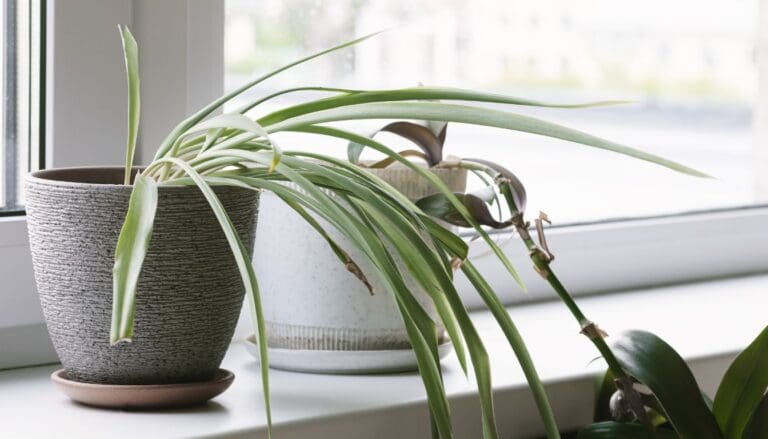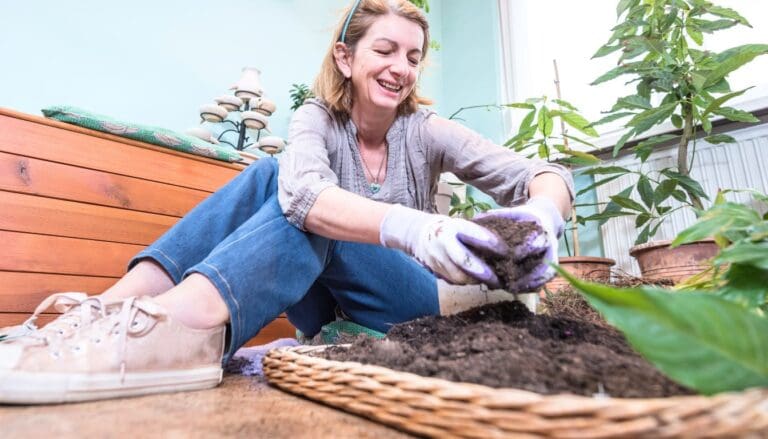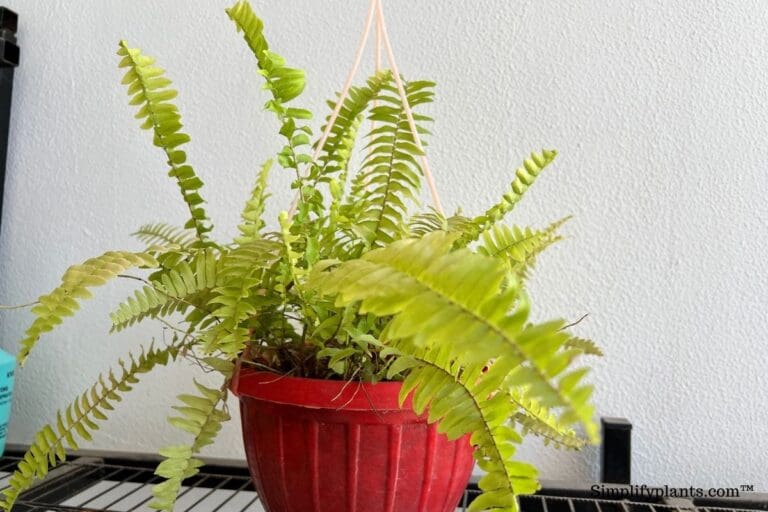What Kind Of Pot Is Best For Calathea? (Pot Size, Type, & More)
Calatheas are one of the common houseplants famous for their colorful designed leaves. They are fussy, and it becomes vital to know what kind of pot is best for calathea and when should you repot them.
In general, ceramic pots and terracotta pots are popular pot choices for calatheas as they allow better drainage and aeration of the soil. The pot must have adequate drainage holes, but it should keep the soil moist as well. Choose a 1-2 inch bigger pot than the current one.
Never go with too big or too small of a pot because the size matters to avoid overwatering and root-bound plants.
If you wish to grow Calatheas, you want to know what you should put the plant in, and this guide will help you understand what kind of pot will be best to put Calatheas.
We will also discuss which kind of soil you should plant your Calatheas.

Please note: Simplify Plants is reader-supported. Some links in the post are affiliate links and I get a commission from purchases made through links in the post.
What should I put my Calatheas in?
Generally, a Calathea should be put in a pot. A pot that is in the correct size has good material and has suitable drainage holes is what Calathea favors.
You should also put or plant your Calathea in suitable potting soil along with the right pot.
Let’s elaborate to help you understand.
Putting Calathea in a correct size pot
Calatheas are finicky-natured. They will react negatively to any unfavorable conditions. So, when you plan to put your Calathea in a pot, you need to choose the right size pot.
The size of the pot should rely on the size of the plant.
For instance, let’s talk about Calathea Medallion. The plant has oval-shaped leathery foliage, having feathers painted on its surface with a maroon underbelly.
The plant will grow until it reaches 3 feet in height. The Medallion can make an excellent indoor plant, and it will look fantastic when put in a small container.
If you want to grow Calathea Medallion, you will need a pot with a width of about 10 inches to 20 inches diameter and a depth of about 10 inches.
The more space the roots will grow, the healthier will be your Calathea.
Like this, you need to select an ideal pot size for your plant. There are many varieties of Calatheas available. So choose an ideal size wisely.
If given a rough idea, choose a pot with 1-inch wide diameter than your plant’s root mass diameter. If you want to give them enough space, choose a pot with a diameter of 4 inches wide.
You need to choose a pot 1 to 2 inches bigger than the existing one for repotting. This will give your Calatheas enough space to grow. Don’t jump to too big a size.
Now, you might think about what might happen if the pot is small or big. Read the following points to know.
Will Calathea like to be put in a small pot?
Calathea will not like a pot smaller than the plant’s size because it will not tolerate the root-bound condition.
When you use a smaller pot for Calatheas, the plant outgrows the pot, and its roots come out from the soil surface and the bottom of drainage holes. There are more roots than soil.
In such conditions, the plant will not get enough water and nutrients. Due to this, they will become yellow, brown, droopy, wilted, and many more problems can arise.
Also read: Do Calathea Like To Be Root Bound? (+When To Repot)
Will Calathea like to be in a large pot?

Similarly, Calathea will also not enjoy growing in a large pot. A big pot will need a lot of soil to be filled.
If the plant size is small and the amount of soil is too much, the soil will remain wet for prolonged periods. Calathea will not like such prolonged damp conditions. This will lead to overwatering and root rot.
For these reasons, the correct pot size is necessary.
Also read: What happens when you put a plant in too big of a pot?
Putting Calathea in the right kind of pot
Various kinds of pot are available in the market. Various shapes and sizes, like square, cubic, or round. You can use any of these.
All of these are suitable for the plant’s healthy growth. But whatever pot you use should have suitable drainage holes to flow excess water during watering.
However, choosing a good pot material for Calatheas can save water issues. Calatheas love moist soil, not soaked or soggy soil.
If you always mistake overwatering your plant, you can choose a terra cotta pot for Calatheas. They are porous pots and can wick away moisture quickly.
So, even if you overwater your plant, the pot will help to reduce the moisture level and keep your plant evenly moist.
Calatheas are tropical plants that grow under the forest canopies of rainforest trees. They would not enjoy drought conditions.
If you don’t have enough time to water the plant regularly and tend to underwater them, you can use glazed ceramic, fiberglass, or plastic pots. These pot materials can hold moisture for a long time.
Some pots don’t have drainage holes, primarily decorative pots. You can drill a hole yourself. But wait. You might not need to do that.
You have the option of cachepots. Use a small pot having enough drainage holes, and put your Calathea in it. Now, put this potted Calathea into the decorative pot.
Before watering, take out this cachepot. After all the excess water drains out of the potholes, put the plant back in the main pot.
Will Calathea like to be put in a self-watering pot?
If you want to keep the Calatheas from overwatering and underwatering, you can use a self-watering pot for Calatheas. This kind of pot would work best for them.
You just need to fill up the reservoir, and the pot will give the required water to them accordingly. You don’t have to intervene daily.
Some self-watering pots come with a water indicator that helps track the water level without frequent checking. However, you will have to check the reservoir to track the water level. This pot can help you with that too.
The indicator will tell you when to add water and how much to add.
In what kind of soil should you plant your Calathea?

It is not only the right type and size of pot you should consider putting your Calathea in. Along with the pot, you should also consider the correct soil type.
A soil that can retain enough moisture and at the same time is well-drained and well-aerated will be good for Calatheas.
A soil that drains water too quickly will not work well for Calatheas. As Calatheas like moist soil, fast-draining soil can take away moisture too quickly, leaving the soil dry.
Being tropical plants, Calathea will not enjoy such conditions.
On the other hand, soil that drains too slowly can make the soil soggy and waterlogged. Calatheas are sensitive to such damp conditions. This might cause overwatering and root rot in more severe conditions, which is another scary story.
Such stressed plants will always become susceptible to pests and fungal infections.
Thus, it is necessary to use the correct potting soil for Calatheas.
An elementary way of getting the best potting soil for Calatheas is a commercial potting mix.
If you want to put your Calathea in your own-made soil mix, that too will work. But, you need to make the medium where Calatheas can grow well.
Recipe 1:
- 1 part organic soil
- 1 part coco peat
- 1 part perlite
- A handful of compost/worm casting
Recipe 2:
- 25% Coco coir
- 25% Perlite
- 25% Orchid bark
- 10% Worm castings
- 5% activated charcoal
These ingredients will make the soil well-drained, well-aerated, and good at retaining moisture. You can also add a 1-2 inches layer of mulch. This will help to absorb and retain moisture and control soil temperature.
Also read: What Kind Of Soil Is Best For Calathea? (Best Soil Mix For Calathea)
How do you keep the Calathea healthy?

Along with ideal pot and soil, there are other things too which you should consider keeping the Calatheas healthy.
Below are some tips which will give you a brief idea about Calathea’s ideal growing conditions and environment.
Appropriate light
Calathea is a tropical plant that loves to grow in indirect, filtered, and bright sunlight. In their native land, they thrive under the forest canopies.
You can locate them near an east or north-facing window to give them bright indirect sunlight, but it might not be sufficient.
If you have kept your Calathea near a south or west-facing windowsill, fix a filter, like curtains or window films, to let them have filtered light as direct sunlight can cause the leaf patterns to fade and cause sunburns.
In extreme low light conditions, you can use grow lights.
Also read: How Much Light Do Calathea Plants Need? (Calathea Plant Light Requirements)
Water them adequately
Calathea needs to remain evenly moist. Watering them once a week will work well. In extreme good growing conditions, or during hot summers, they might take up water too quickly.
At that time, increase the watering frequency. Keep checking the moisture level. Avoid watering in winter because Calatheas go dormant in cold weather.
Also read: How Often To Water Calathea? (A Complete Calathea Watering Guide)
Give them high humidity

Being tropical plants, Calatheas will require humidity ranging from 50% to 60%. There are many ways to arrange proper humidity.
- Fix a humidifier in your room. It will mimic the exact humid environment like their native land.
- Keep a pebble tray filled with water under the pot to give them enough humidity.
- If you own many tropical plants, you can group them. This can increase humidity by around 10% to 15%.
Also read: Should I Mist My Calathea Plant? (Calathea Humidity Requirements)
Save them from cold drafts.
Calathea enjoys warm conditions. In cold weather, they stop their growth. You need to save them from a cold climate. Let them get room temperature.
Keep Calatheas away from air conditioners and direct fans.
Place them away from open windows with cold winds during winter.
Add a layer of mulch to the soil surface to stabilize the soil temperature. Avoid regular watering in winter.
Also read: What Temperature Can Calathea Tolerate? (Ideal Temperature Range)
Fertilize as required
Calatheas don’t need much fertilizer, unlike other plants. You can feed the Calathea once a month during its growing seasons.
If the conditions are too good, they might take up more food. In that case, fertilize them after every 2 weeks with a balanced fertilizer.
If you wish to use organic fertilizer, you can use bone meal, fish emulsion, rock phosphate, eggshells, coffee grounds, etc.
Water your plant after feeding to help distribute the nutrients evenly.
Also read: Should I Fertilize Calathea? (How Often+Best Fertilizer)
Repot the plant

Repot your Calathea when needed. Even if the plant is in good size and shape in its existing pot, repotting can give it more space to grow without being rootbound.
Repotting with new soil will fuel your Calathea to grow more vigorously.
Besides repotting Calatheas when they are outgrown, you can generally repot Calathea once or every other year.
As I mentioned earlier, choose a pot only 1-2 inches bigger than the current one. Avoid fertilizing for 4-6 weeks after transplanting.
Check out for pests and diseases.
Pests and diseases will attack Calatheas when they are stressed, like underwatering, overwatering, or overfertilizing.
You should not let any of these happen. Besides, you should clean the leaves regularly to keep them dust-free. Use leaf wipers or damp cloth for cleaning. Don’t leave the foliage wet for long.
If Calatheas show signs like yellow leaves, brown spots on the leaf surface, or brown leaves, you better detect the problem as soon as possible, discard these affected leaves and start treating the problem.
Misting them with neem oil once a month can save them from infestation. But, while using this oil, you should not expose them to direct sun.
Also read: Do Calathes Attract Bugs? (Common Pest+Solution)
Propagate
If you want more Calatheas, propagation is the best option.
Sometimes, when the plant suffers so much that bringing them back is impossible, you can propagate them by cutting the good portions of the plant, if any left.
You can prune the section to the stems and plant the cuttings in new soil or water. You can also dig up the plant’s root ball and divide it as required before repotting.
Final thoughts
So, when the question arises where to put Calatheas in, I would say you should put them in a pot with an ideal size, enough drainage holes, and a material that can keep the plant moist and healthy.
Choose a pot size depending on the plant’s size. Make sure it has drainage holes. Choose pot material that you think would be ideal, either terra cotta or ceramic or plastic or fiberglass.
You can use a self-watering pot for Calatheas to save them from water issues. Along with the pot, take care of the soil too. Use soil that is well-drained, well-aerated, and remains evenly moist all the time.
Give them all their basic needs to keep them healthy and long-lasting.
Source: NCBI, University of Florida, Wikipedia, Growing Indoor Plants with Success, Agriculture, and Natural Resources, University of California, Missouri Botanical Garden.
Recommended Garden Supplies
| Product Image | Our Recommended Gardening Supplies | Check Offers! |
|---|---|---|
Top Top
Top
Top
Top
Top
Top
Top
Top | rePotme Houseplant and Tropical Classic Potting Soil Mix | Check Offer On Amazon |
 Top
Top
Top
Top
Top
Top
Top
Top | Espoma Organic Indoor Plant Food | Check Offer On Amazon |
 Top
Top
Top
Top
Top
Top
Top
Top | GooingTop LED Grow Light 6000K Full Spectrum Clip Plant Growing Lamp | Check Offer On Amazon |
 Top
Top
Top
Top
Top
Top
Top
Top | Soil Moisture Meter | Check Offer On Amazon |
 Top
Top
Top
Top
Top
Top
Top
Top | Govee Hygrometer Thermometer, Bluetooth Enabled! | Check Offer On Amazon |
 Top
Top | LEVOIT Humidifiers for Large Room(Best For Plants) | Check Offer On Amazon |
 Top
Top
Top
Top
Top
Top
Top
Top | Upgraded DIY Automatic Drip Irrigation Kit, 15 Potted Houseplants Support | Check Offer On Amazon |
 Top
Top
Top
Top
Top
Top
Top
Top | Stainless Steel Heavy Duty Gardening Tool Set | Check Offer On Amazon |
 Top
Top
Top
Top
Top
Top
Top
Top | Bonide Insecticidal Soap | Check Offer On Amazon |
 Top
Top
Top
Top
Top
Top
Top
Top | Bonide 32 oz Spray Neem Oil for Organic Gardening | Check Offer On Amazon |
 Top
Top
Top
Top
Top
Top
Top
Top | Garden Safe Fungicide | Check Offer On Amazon |





